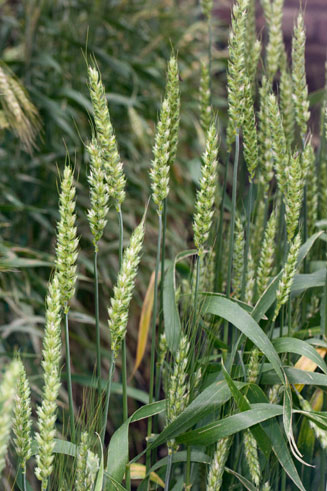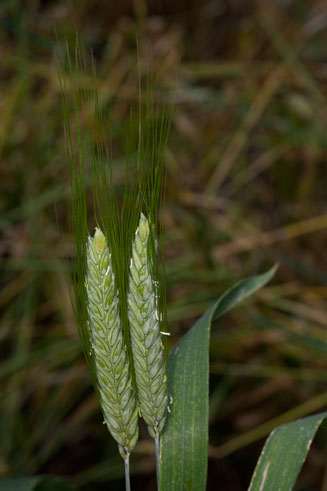|
Triticum (wheat genus) Life
> eukaryotes >
Archaeoplastida >
Chloroplastida
>
Charophyta > Streptophytina > Plantae (land plants)
> Tracheophyta (vascular plants) > Euphyllophyta > Lignophyta (woody plants)
> Spermatophyta (seed plants) > Angiospermae (flowering
plants) > Monocotyledons > Order: Poales
> Family: Poaceae
 |
 |
|
Triticum aestivum under cultivation in
Vienna Botanical Gardens, Austria. [photos
H.G.
Robertson, Iziko ©] |
The two main types of wheat used these days are Durum
wheat Triticum turgidum and bread wheat Triticum aestivum. Durum
wheat is a variety of Emma wheat, the latter of which was the first type of
wheat to be domesticated, about 9000 years ago. Bread wheat is derived from the
hybridization of Emma wheat with the wild grass Aegilops squarrosa, which
happened about 6700 years ago. Wheat is now the world's major crop in terms of
food production.
Wheat is the World's major crop in terms of food production. Of the total
food produced by the World's top 30 crops (based on dry matter), about 23.4%
comes from wheat, followed by maize (21.5%) and rice (16.5%) (Harlan
1995).
The objectives of wheat domestication
- To produce 'non-shattering' varieties that have
seeds that are not lost by breaking off the plant before harvest. Wild
grasses are adapted to dispersing their seeds by releasing them once ripe
but grasses under cultivation, such as wheat, need to have seeds that are
retained and only break off during the threshing process. Selection of
non-shattering varieties would have occurred quickly once cultivation
started, as it was only these plants that would have been successfully
harvested.
- To produce large, plump seeds.
- To produce more seeds per plant by increasing
the number of fertile flowers (termed florets in grasses).
- To produce 'free-threshing' or 'naked'
varieties where the husk round the seed comes off during threshing. All's
that needs to be done after threshing is for the grain to be winnowed so
that the empty husks (i.e. chaff) are blown away from the seeds. Wild
varieties of wheat are hulled - i.e. the seeds are covered by a tough
husk that stays round the seed once it has been threshed. To get this husk
off the seed, it has to be pounded in some way which is more laborious than
winnowing the husks away and means the grain is broken and less suitable for
storing.
- To produce seeds that germinate together. Wild
forms are adapted to delay germination until there are suitable conditions
and to vary the timing of germination so that seeds do not grow up and
die altogether during a season of erratic and poor rainfall.
There are four species in the wheat genus:
Triticum monococcum (Einkorn Wheat).Has
two sets of chromosomes (i.e. diploid). Most varieties produce only one
grain per spikelet, hence its latin and common names. It was domesticated
from wild forms in the Near East about 9000 years ago to produce plants with
plumper seeds that did not break off the plant before harvest. Einkorn Wheat
was grown extensively during the Neolithic period but from the Bronze Age
on, its importance wained in favour of the Emmer and Bread wheat varieties.
It is now a relic crop, grown in the Balkans (i.e. countries between the
Adriatic and Aegean Seas - Yugoslavia, Albania, Rumania, Bulgaria, Greece
and western Turkey), Germany, Switzerland, Spain and Caucasia. -
Triticum turgidum (Emmer and Durum Wheat). Has
four sets of chromosomes (i.e. tetraploid). Emmer Wheat is hulled (see
above) and was selected and cultivated from wild forms. Durum Wheat is the
predominant variety that was selected from Emmer Wheat and has
free-threshing grain.
-
Triticum timopheevi (Timopheev's Wheat). Like
T. turgidum it is also tetraploid. Wild and cultivated Timopheev's
Wheat is only known from a small region in Georgia (between the Black and
Caspian seas) and has never gained prominance in World agriculture.
-
Triticum aestivum (Bread Wheat). Has six
sets of chromosomes (i.e. hexaploid). Bread Wheat was produced under
cultivation by the hybridisation of Triticum turgidum with the wild
grass Aegilops squarrosa, about 4700 BC. The first variety formed
from this hybridisation is termed Spelta Wheat and has hulled seeds. Later
on, free-threshing varieties were formed.
A number of other species names have been used in the past
to refer to various varieties within the above four types but these names are
usually no longer used in modern species classifications of wheat.
History of Wheat domestication
| Event |
Year |
| People were collecting and eating wild Emmer
Wheat in the Near East (as well as barley). Evidence for this comes from the finding of
wild Emmer Wheat seeds in an archaeological site on the shores of the Sea
of Galilee in Israel. |
c 17000 BC |
| People were collecting and eating wild Einkorn
Wheat in the Near East and were probably doing so well before this.
Evidence from this stems from the finding of carbonised remains of wild
Einkorn Wheat seeds in archaeological sites in northern Syria. Seeds of
the wild forms can be distinguised from the domesticated forms because
they are thinner in appearance. |
c10000 BC |
| People had domesticated hulled Emmer Wheat
through selection of plants with plumper seeds than wild forms which were
non-brittle so they were retained during harvesting and only shed through
the threshing process. Evidence for this comes from the occurrence of
plump Emmer Wheat seeds at an archaeological site near Damascus in Israel.
Emmer Wheat was the main cereal crop in the Near East from the very
beginnings of agriculture in this region. It also came to be cultivated
further afield in the Aegean region (e.g. Greece), on the Balkan Peninsula
and in central Europe and remained the main cereal crop through the Neolithic period and into the Bronze Age although Einkorn Wheat was often
grown as well. |
c 7800 BC |
| Einkorn Wheat had been domesticated
through selection and propagation of plants with plumper seeds than wild
forms. Evidence for this domestication comes from finding these
plumper seeds at archaeological sites in Syria, Turkey and Iran. With time
Einkorn Wheat becomes a major crop in the near East in the Neolithic
period. It spread further than this in the Neolithic period to Cyprus,
Greece, the Balkan Peninsula, Europe and the Caucasus. For instance,
domesticated Einkorn has been found in in Greek agricultural settlements
dating back to 6000-6500 BC. |
c7000 BC |
| Selection of free-threshing, naked, forms of Emmer Wheat
has been successful although hulled Emmer and Einkorn continue to be
grown. However, by the Late Bronze Age, growing of naked wheats
predominated in the Mediterranean and Near East regions. Durum Wheat
is derived from these naked wheat types. |
6000-7000 BC |
| Earliest record of people
using Bread Wheat (the hulled Spelta variety). This occurred in the
Caucasus region between the Black and Caspian Seas which makes sense
because this is within the main geographical distribution of Aegilops
squarrosa which is the grass that at some stage formed a fertile
hybrid with cultivated Emmer Wheat to form Bread Wheat. Free-threshing,
naked, Bread Wheat is thought to have developed soon afterwards (before
4000 BC). |
4700 BC |
References
-
Harlan, J.R. 1995. The living fields - our
agricultural heritage. Cambridge University Press, Cambridge.
-
Sauer, J.D. 1993. Historical geography of
crop plants - a select roster. CRC Press, Boca Raton, Florida.
-
Zohary, D. & Hopf, M. 1993. Domestication
of plants in the old World - The origin and spread of cultivated plants in
West Asia, Europe, and the Nile Valley. Clarendon Press, Oxford.
Text by Hamish Robertson |
